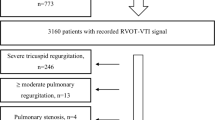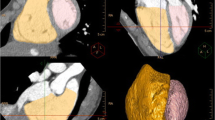Abstract
Purpose
No groups have yet succeeded in identifying the need for re-repair of residual shunt after surgical repair of ventricular septal defect (VSD) based on quantitative evaluation of the ratio of the pulmonary blood flow to the systemic blood flow (Qp/Qs) by transesophageal echocardiography (TEE). Hence, we studied the accuracy of Qp/Qs as estimated by intraoperative TEE.
Methods
Twenty-six patients undergoing VSD closure were studied. After separation from the cardiopulmonary bypass, the presence and severity of residual leakage was evaluated by color Doppler image, and the Qp/Qs (TEE-derived Qp/Qs) was calculated by measuring the vessel diameter and the velocity–time integral of the flow profiles in the main pulmonary artery and left ventricular outflow tract. Transthoracic echocardiography (TTE) was performed at pre-discharge and at 6–12 months after the correction to confirm the presence and severity of residual leakage.
Results
TEE detected only minor leakage, with no indication for re-repair, in 8 of the 26 patients. Nevertheless, TEE-derived Qp/Qs varied from 0.57 to 2.07 and were incorrect in 17 patients (65.4%). This meant that when TEE-derived Qp/Qs was outside the acceptable range, the patient was judged not to be in need of re-repair. TTE at pre-discharge confirmed trivial leakage in 3 patients in whom TEE had also identified similar leakages. These leakages were not observed at the follow-up TTE.
Conclusion
TEE-derived Qp/Qs lacks the accuracy required to play a crucial role in quantitatively measuring the severity of residual shunt, while two-dimensional TEE can reliably detect residual leakage after VSD closure and lead to optimal judgment on the need for re-repair.

Similar content being viewed by others
References
Muhiudeen IA, Silverman NH, Anderson RH. Transesophageal transgastric echocardiography in infants and children: the subcostal view equivalent. J Am Soc Echocardiogr. 1995;8:231–44.
Stevenson JG, Sorensen GK, Gartman DM, Hall DG, Rittenhouse EA. Transesophageal echocardiography during repair of congenital cardiac defects: identification of residual problems necessitating reoperation. J Am Soc Echocardiogr. 1993;6:356–65.
Sheil ML, Baines DB. Intraoperative transesophageal echocardiography for paediatric cardiac surgery—an audit of 200 cases. Anaesth Intensive Care. 1999;27:591–5.
Rosenfeld HM, Gentles TL, Wernovsky G, Laussen PC, Jonas RA, Mayer JE Jr, Colan SD, Sanders SP, van der Velde ME. Utility of intraoperative transesophageal echocardiography in the assessment of residual cardiac defects. Pediatr Cardiol. 1998;19:346–51.
Galli KK, Gaynor JW, DeCampli WM, Karl TR, Splay TL, Rychik J. The impact of intraoperative transesophageal echocardiography on reinstitution of cardiopulmonary bypass following surgery for congenital heart disease. Cardiol Young. 2001;11(Suppl 1):76.
Sabry AF, Reller MD, Silberbach M, Rice MJ, Sahn DJ. Comparison of four Doppler echocardiographic methods for calculating pulmonary-to-systemic shunt flow ratios in patients with ventricular septal defect. Am J Cardiol. 1995;75:611–4.
Cloez JL, Schmidt KG, Birk E, Silverman NH. Determination of pulmonary to systemic blood flow ratio in children by a simplified Doppler echocardiographic method. J Am Coll Cardiol. 1988;11:825–30.
Dittmann H, Jacksch R, Voelker W, Karsch KR, Seipel L. Accuracy of Doppler echocardiography in quantification of left to right shunts in adult patients with atrial septal defect. J Am Coll Cardiol. 1988;11:338–42.
Marx GR, Allen HD, Goldberg SJ, Flinn CJ. Transatrial septal velocity measurement by Doppler echocardiography in atrial septal defect: correlation with Qp:Qs ratio. Am J Cardiol. 1985;15:1162–7.
Mahmood M, Haque SS, Siddique MA, Ahmed CM, Hossain Z. Doppler evaluation of left to right shunt (Qp/Qs) in patients with isolated ventricular septal defect (Vsd). Mymensingh Med J. 2007;16:181–6.
Kosecik M, Sagin-Saylam G, Unal N, Kir M, Paytoncu S. Noninvasive assessment of left-to-right shunting in ventricular septal defects by the proximal isovelocity surface area method on Doppler colour flow mapping. Can J Cardiol. 2007;23:1049–53.
Darmon PL, Hillel Z, Mogtader A, Mindrich B, Thys D. Cardiac output by transesophageal echocardiography using continuous-wave Doppler across the aortic valve. Anesthesiology. 1994;80:796–805.
Maslow A, Comunale ME, Haering JM, Watkins J. Pulsed wave Doppler measurement of cardiac output from the right ventricular outflow tract. Anesth Analg. 1996;83:466–71.
Savino JS, Troianos CA, Aukburg S, Weiss R, Reichek N. Measurement of pulmonary blood flow with transesophageal two-dimensional and Doppler echocardiography. Anesthesiology. 1991;75:445–51.
Perrino AC Jr, Harris SN, Luther MA. Intraoperative determination of cardiac output using multiplane transesophageal echocardiography: a comparison to thermodilution. Anesthesiology. 1998;89:350–7.
Zhao X, Mashikian JS, Panzica P, Lerner A, Park KW, Comunale ME. Comparison of thermodilution bolus cardiac output and Doppler cardiac output in the early post-cardiopulmonary bypass period. J Cardiothorac Vasc Anesth. 2003;17:193–8.
Roewer N, Bednarz F, Dziadzka A, Schulte am Esch J. Intraoperative cardiac output determination from transmitral and pulmonary blood flow measurements using transesophageal pulsed Doppler echocardiography (abstract). Anesthesiology 1987;67:A639.
Katayama H, Henry GW, Lucas CL, Ha B, Ferreiro JI, Frantz EG, Krzeski R. Three-dimensional visualization of pulmonary blood flow velocity profiles in lambs. Jpn Heart J. 1992;33:95–111.
Lucas CL, Henry GW, Ferreiro JI, Ha B, Keagy BA, Wilcox BR. Pulmonary blood velocity profile variability in open-chest dogs: influence of acutely altered hemodynamic states on profiles, and influence of profiles on the accuracy of techniques for cardiac output determination. Heart Vessels. 1998;4:65–78.
Bashein G, Detmer PR: Principles of Doppler ultrasound. In: Sidebotham D, Merry A, Legget M, editors. Practical perioperative transesophageal echocardiography. 1st ed. Edinburgh, Butterworth-Heinemann; 2003. p. 33–44.
Loeber CP, Goldberg SJ, Marx GR, Carrier M, Emery RW. How much does aortic and pulmonary artery area vary during the cardiac cycle? Am Heart J. 1987;113:95–100.
Ueda Y, Hozumi T, Yoshida K, Watanabe H, Akasaka T, Takagi T, Yamamuro A, Homma S, Yoshikawa J. Non-invasive automated assessment of the ratio of pulmonary to systemic flow in patients with atrial septal defects by the colour Doppler velocity profile integration method. Heart. 2002;88:278–82.
Dodge-Khatami A, Knirsch W, Tomaske M, Pretre R, Bettex D, Rousson V, Bauersfeld U, Kanter KR. Spontaneous closure of small residual ventricular septal defects after surgical repair. Ann Thorac Surg. 2007;83:902–6.
Yang SG, Novello R, Nicolson S, Steven J, Gaynor JW, Spray TL, Rychik J. Evaluation of ventricular septal defect repair using intraoperative transesophageal echocardiography: frequency and significance of residual defects in infants and children. Echocardiography. 2000;17:681–4.
Author information
Authors and Affiliations
Corresponding author
About this article
Cite this article
Kurokawa, S., Honma, T., Taneoka, M. et al. Can intraoperative TEE correctly measure residual shunt after surgical repair of ventricular septal defects?. J Anesth 24, 343–350 (2010). https://doi.org/10.1007/s00540-010-0896-3
Received:
Accepted:
Published:
Issue Date:
DOI: https://doi.org/10.1007/s00540-010-0896-3




